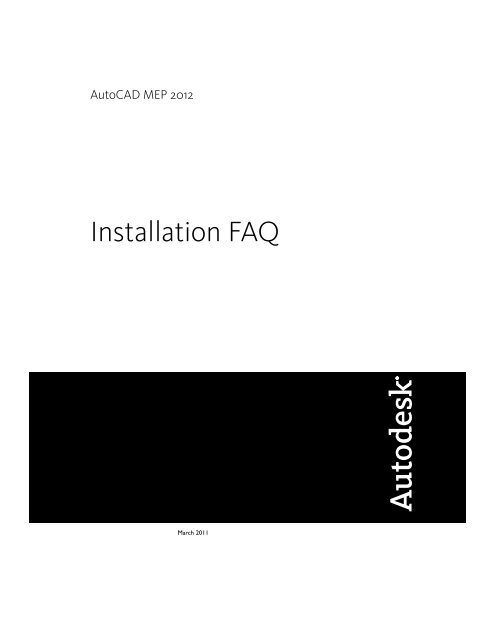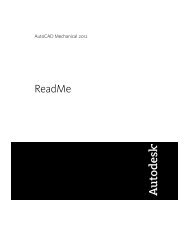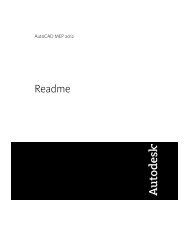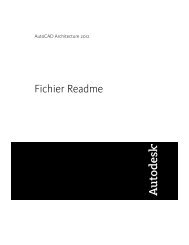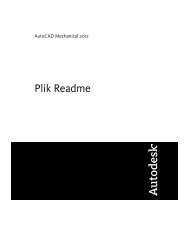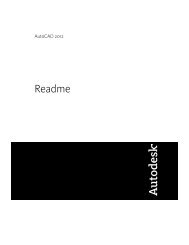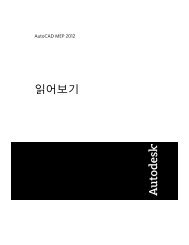AutoCAD MEP 2012 Installation FAQ - Exchange - Autodesk
AutoCAD MEP 2012 Installation FAQ - Exchange - Autodesk
AutoCAD MEP 2012 Installation FAQ - Exchange - Autodesk
You also want an ePaper? Increase the reach of your titles
YUMPU automatically turns print PDFs into web optimized ePapers that Google loves.
<strong>AutoCAD</strong> <strong>MEP</strong> <strong>2012</strong><strong>Installation</strong> <strong>FAQ</strong>March 2011
©2011 <strong>Autodesk</strong>, Inc. All Rights Reserved. Except as otherwise permitted by <strong>Autodesk</strong>, Inc., this publication, or parts thereof, may notbe reproduced in any form, by any method, for any purpose.Certain materials included in this publication are reprinted with the permission of the copyright holder.TrademarksThe following are registered trademarks or trademarks of <strong>Autodesk</strong>, Inc., and/or its subsidiaries and/or affiliates in the USA and other countries:3ds Max, Algor, Alias, Alias (swirl design/logo), AliasStudio, ATC, AUGI, <strong>AutoCAD</strong>, <strong>AutoCAD</strong> Learning Assistance, <strong>AutoCAD</strong> LT, <strong>AutoCAD</strong> Simulator,<strong>AutoCAD</strong> SQL Extension, <strong>AutoCAD</strong> SQL Interface, <strong>Autodesk</strong>, <strong>Autodesk</strong> Intent, <strong>Autodesk</strong> Inventor, <strong>Autodesk</strong> MapGuide, <strong>Autodesk</strong> Streamline,AutoLISP, AutoSnap, AutoSketch, AutoTrack, Backburner, Backdraft, Beast, Built with ObjectARX (logo), Burn, Buzzsaw, CAiCE, Civil 3D, Cleaner,Cleaner Central, ClearScale, Colour Warper, Combustion, Communication Specification, Constructware, Content Explorer, Dancing Baby (image),DesignCenter, Design Doctor, Designer's Toolkit, DesignKids, DesignProf, DesignServer, DesignStudio, Design Web Format, Discreet, DWF,DWG, DWG (logo), DWG Extreme, DWG TrueConvert, DWG TrueView, DWFX, DXF, Ecotect, Exposure, Extending the Design Team, Face Robot,FBX, Fempro, Fire, Flame, Flare, Flint, FMDesktop, Freewheel, GDX Driver, Green Building Studio, Heads-up Design, Heidi, Homestyler, HumanIK,IDEA Server, i-drop, Illuminate Labs AB (design/logo), ImageModeler, iMOUT, Incinerator, Inferno, Inventor, Inventor LT, Kynapse, Kynogon,LandXplorer, LiquidLight, LiquidLight (design/logo), Lustre, MatchMover, Maya, Mechanical Desktop, Moldflow, Moldflow Plastics Advisers,Moldflow Plastics Insight, Moldflow Plastics Xpert, Moondust, MotionBuilder, Movimento, MPA, MPA (design/logo), MPI, MPI (design/logo),MPX, MPX (design/logo), Mudbox, Multi-Master Editing, Navisworks, ObjectARX, ObjectDBX, Opticore, Pipeplus, PolarSnap, PortfolioWall,Powered with <strong>Autodesk</strong> Technology, Productstream, ProMaterials, RasterDWG, RealDWG, Real-time Roto, Recognize, Render Queue, Retimer,Reveal, Revit, RiverCAD, Robot, Scaleform, Scaleform GFx, Showcase, Show Me, ShowMotion, SketchBook, Smoke, Softimage, Softimage|XSI(design/logo), Sparks, SteeringWheels, Stitcher, Stone, StormNET, Tinkerbox, ToolClip, Topobase, Toxik, U-Vis, ViewCube, Visual, Visual LISP,Voice Reality, Volo, Vtour, WaterNetworks, Wire, Wiretap, WiretapCentral, XSI.Third Party Software Program CreditsSpatial, ACIS, and SAT are either registered trademarks or trademarks of Spatial Corp. in the United States and/or other countries.ACIS ® © 1989-2002 Spatial Corp.Adobe ® Flash ® Player, Copyright © 1996-2006 Adobe Systems Incorporated. All Rights Reserved, Protected by U.S. Patent 6,879,327; PatentsPending in the United States and other countries. Adobe and Flash are either trademarks or registered trademarks in the United States and/orother countries.International CorrectSpell Spelling Correction System © 1995 by Lernout & Hauspie Speech Products, N.V. All rights reserved. Portions relatedto InstallShield are Copyright © 1996 2009 Acresso Software Inc. and/or InstallShield Co. Inc. All Rights Reserved.PANTONE ® Colors displayed in the software application or in the user documentation may not match PANTONE-identified standards. Consultcurrent PANTONE Color Publications for accurate color.PANTONE ® and other Pantone trademarks are the property of Pantone LLC. © Pantone LLC 2010Pantone is the copyright owner of color data and/or software which are licensed to <strong>Autodesk</strong>, Inc., to distribute for use only in combinationwith certain <strong>Autodesk</strong> software products. PANTONE Color Data and/or Software shall not be copied onto another disk or into memory unlessas part of the execution of this <strong>Autodesk</strong> software product.Portions Copyright © 1991-1996 Arthur D. Applegate. All rights reserved.Portions of this software are based on the work of the Independent JPEG Group.RAL DESIGN © RAL, Sankt Augustin, 2002RAL CLASSIC © RAL, Sankt Augustin, 2002Representation of the RAL Colors is done with the approval of RAL Deutsches Institut für Gütesicherung und Kennzeichnung e.V. (RAL GermanInstitute for Quality Assurance and Certification, re. Assoc.), D-53757 Sankt Augustin.Typefaces from the Bitstream ® typeface library copyright 1992.Typefaces from Payne Loving Trust © 1992, 1996. All rights reserved.Printed manual and help produced with Idiom WorldServer .WindowBlinds: DirectSkin OCX © Stardock ®AnswerWorks 4.0 © ; 1997-2003 WexTech Systems, Inc. Portions of this software © Vantage-Knexys. All rights reserved.The Director General of the Geographic Survey Institute has issued the approval for the coordinates exchange numbered TKY2JGD for JapanGeodetic Datum 2000, also known as technical information No H1-N0.2 of the Geographic Survey Institute, to be installed and used withinthis software product (Approval No.: 646 issued by GSI, April 8, 2002).Portions of this computer program are copyright © 1995-1999 LizardTech, Inc. All rights reserved. MrSID is protected by U.S. Patent No.5,710,835. Foreign Patents Pending.Portions of this computer program are Copyright © ; 2000 Earth Resource Mapping, Inc.OSTN97 © Crown Copyright 1997. All rights reserved.OSTN02 © Crown copyright 2002. All rights reserved.OSGM02 © Crown copyright 2002, © Ordnance Survey Ireland, 2002.FME Objects Engine © 2005 SAFE Software. All rights reserved.<strong>AutoCAD</strong> ® and <strong>AutoCAD</strong> LT ® products are produced under a license of data derived from DIC Color Guide ® from Dainippon Ink and Chemicals,Inc. Copyright © Dainippon Ink and Chemicals, Inc. All rights reserved. DIC and DIC Color Guide are registered trademarks of Dainippon Inkand Chemicals, Inc.Government UseUse, duplication, or disclosure by the U.S. Government is subject to restrictions as set forth in FAR 12.212 (Commercial ComputerSoftware-Restricted Rights) and DFAR 227.7202 (Rights in Technical Data and Computer Software), as applicable.
ContentsChapter 1 Introduction . . . . . . . . . . . . . . . . . . . . . . . . . . . . 1<strong>Installation</strong> Overview . . . . . . . . . . . . . . . . . . . . . . . . . . . 1Chapter 2 Installing <strong>AutoCAD</strong> <strong>MEP</strong> on a Single Computer . . . . . . . . . . 5How can I prepare for a successful installation? . . . . . . . . . . . . . . 5How can I choose the language in which the Installer instructionsare presented? . . . . . . . . . . . . . . . . . . . . . . . . . . . . . . . 5How do I choose the language for my software? . . . . . . . . . . . . . 6Where can I find my serial number and product key? . . . . . . . . . . . 6What if I've lost my serial number or product key? . . . . . . . . . . . . 6How do I know if I have enough disk space for the installation? . .7How do I select a license type? What is the difference between astand-alone license and a network license? . . . . . . . . . . . . . . . 7What is the purpose of a client log file? . . . . . . . . . . . . . . . . . . 8How do I register and activate my software after I have finished theinstallation? . . . . . . . . . . . . . . . . . . . . . . . . . . . . . . . 8What are the additional products available for installation? . . . . . . . 8Where do I customize my installation? . . . . . . . . . . . . . . . . . . 8What are content packs and how do I install them? . . . . . . . . . . . 9What are configurable folders? . . . . . . . . . . . . . . . . . . . . . . 10How can I install medium resolution Material Library images? . . . . . 12iii
How can I be sure available service packs are included in myinstallation? . . . . . . . . . . . . . . . . . . . . . . . . . . . . . . . 12What features can I customize? . . . . . . . . . . . . . . . . . . . . . 12Chapter 3Creating a Deployment of <strong>AutoCAD</strong> <strong>MEP</strong> to MultipleComputers . . . . . . . . . . . . . . . . . . . . . . . . . . . . 15How can I prepare to create a successful deployment to multiplecomputers? . . . . . . . . . . . . . . . . . . . . . . . . . . . . . . . 15How do I select a license type? What is the difference between astand-alone license and a network license? . . . . . . . . . . . . . . 16How can I choose the language in which the Installer instructionsare presented? . . . . . . . . . . . . . . . . . . . . . . . . . . . . . . 16What is the benefit of a network licensed version of the software?. . . . . . . . . . . . . . . . . . . . . . . . . . . . . . . . . . . . . . 17What is the purpose of a client log file? . . . . . . . . . . . . . . . . . 17What is the purpose of a network log file? . . . . . . . . . . . . . . . . 17What is an administrative image? . . . . . . . . . . . . . . . . . . . . 18Where should the administrative image of my deployment be located?. . . . . . . . . . . . . . . . . . . . . . . . . . . . . . . . . . . . . . 18How will individual users find the deployed administrative image?. . . . . . . . . . . . . . . . . . . . . . . . . . . . . . . . . . . . . . 18What is 'silent' deployment mode? . . . . . . . . . . . . . . . . . . . . 18What are the additional products available for installation? . . . . . . 19Where do I customize my installation? . . . . . . . . . . . . . . . . . 19What features can I customize? . . . . . . . . . . . . . . . . . . . . . 19How can I install medium resolution Material Library images? . . . . . 20How do I include Service Packs with my deployment? . . . . . . . . . . 20What are content packs and how do I install them? . . . . . . . . . . . 21What are configurable folders? . . . . . . . . . . . . . . . . . . . . . . 22What is the purpose of configuring additional files in a deployment?. . . . . . . . . . . . . . . . . . . . . . . . . . . . . . . . . . . . . . 24What are the services of the Communication Center? . . . . . . . . . 24What is <strong>Autodesk</strong> <strong>Exchange</strong>? . . . . . . . . . . . . . . . . . . . . . . . 25How do I modify a deployment configuration? . . . . . . . . . . . . . 25Chapter 4 Maintaining and Reconfiguring Your <strong>Installation</strong> . . . . . . . . 27How do I add or remove features after installation? . . . . . . . . . . . 27What are content packs and how do I install them? . . . . . . . . . . . 27What if I accidentally delete or alter required files? Can I replace orrepair them? . . . . . . . . . . . . . . . . . . . . . . . . . . . . . . 28After repairing my installation, is it possible to recover my settings?. . . . . . . . . . . . . . . . . . . . . . . . . . . . . . . . . . . . . . 28How do I uninstall my software? . . . . . . . . . . . . . . . . . . . . . 29What are the tools and utilities available for installation? . . . . . . . 29iv | Contents
Chapter 5 System Requirements . . . . . . . . . . . . . . . . . . . . . . . 31<strong>AutoCAD</strong> <strong>MEP</strong> <strong>2012</strong> System Requirements . . . . . . . . . . . . . . . 31System Requirements for 32-bit Workstations . . . . . . . . . . . . . . 31System Requirements for 64-bit Workstations . . . . . . . . . . . . . . 33Requirements for GPO (Group Policy Objects) Deployments . . . . . . 35Contents | v
Introduction1<strong>Installation</strong> OverviewThe process of installing or deploying <strong>AutoCAD</strong> <strong>MEP</strong> <strong>2012</strong> consists of the threemain steps shown in the diagram above.■ Preparation is very important for achieving a trouble-free and successfulinstallation.■■Entering Information varies depending upon the kind of installation ordeployment you need.<strong>Installation</strong> or Deployment executes quickly once you have made andspecified your choices.You will either perform an installation on a single computer or create adeployment for multiple computers. In both cases, you decide whether to acceptthe typical default options or select your own options to configure a custominstallation. Although the <strong>AutoCAD</strong> <strong>MEP</strong> Installer has been designed to beself-explanatory, you can find answers to your installation questions in the <strong>FAQ</strong>1
provided here. Note that complete details for creating deployments areprovided in the Network Administrator's Guide.What kind of installation will you perform?Here are the four main installation types with a summary of the data anddecisions they require:■ Typical installation with default options. For a typical installation,begin with a proper preparation (page 5). Then, just click through theinstaller, providing your serial number (page 6), product key (page 6),and license information (page 7). Pre-selected components will be installedwith <strong>AutoCAD</strong> <strong>MEP</strong>.■Custom installation with selected options. For a custom installation,in addition to the items listed above for a typical installation, you will alsoneed to determine:■ Which of the additional bundled products (such as <strong>Autodesk</strong> DesignReview) to install with <strong>AutoCAD</strong> <strong>MEP</strong>.■■■■■■Which features (page 12) (such as Express Tools) to install with<strong>AutoCAD</strong> <strong>MEP</strong>.How to customize the configurable folders.What content packs to install.Select standard content libraries to install.Whether to accept the default to create a desktop shortcut.Whether to install any available service packs (page 12), either from<strong>Autodesk</strong> or from a local or network drive.■Typical deployment with default options. To create a typicaldeployment using default options, in addition to providing your serialnumber, product key, and license information, you will:■ Name your deployment.■ Specify a location for your administrative image (page 18).■ Specify whether you want a network log file (page 17).■■Determine whether to run installations to workstations in silent mode(page 18).Determine whether you want to create a client log file (page 8) in theTemp directory of each workstation.2 | Chapter 1 Introduction
■Custom deployment with selected options. For a custom deployment,in addition to the items listed above for a typical deployment, you willalso specify:■ Which of the additional bundled products (such as <strong>Autodesk</strong> DesignReview) to install with <strong>AutoCAD</strong> <strong>MEP</strong>.■■■■■■■■■Which features (page 12) (such as Express Tools) to install with<strong>AutoCAD</strong> <strong>MEP</strong>.Whether to install any available service packs (page 20) and whetherto merge them with the deployment or append them.Whether to add additional files (page 24) to the deployment.How to customize the configurable folders.What content packs to install.What modifications to make to the default search paths and the locationof some program files.User preferences.Whether to enable access to communication channels (page 24), liveupdates, and RSS feeds.Whether to enable access to online resources.<strong>Installation</strong> Overview | 3
Installing <strong>AutoCAD</strong><strong>MEP</strong> on a SingleComputer2How can I prepare for a successful installation?You can avoid problems and ensure a smooth installation of <strong>AutoCAD</strong> <strong>MEP</strong> byemploying the following best practices:■ Confirm that your computer meets the minimum System Requirements.(Click "System Requirements" at the bottom of the Installer window.)Important: Microsoft .NET Framework 4.0 (available on product disc) mustbe installed before you install <strong>AutoCAD</strong> <strong>MEP</strong>.■ Be sure you have Administrator permissions in Windows ® .■■■■Remove previous installations of this release of <strong>AutoCAD</strong> <strong>MEP</strong>, includingany Beta versions.Install all Microsoft Windows ® system updates and restart your computer.Before you install, exit all active applications. An even better approach is toinstall <strong>AutoCAD</strong> <strong>MEP</strong> first thing after starting your computer, before usingany applications.Turn off your anti-virus program.How can I choose the language in which theInstaller instructions are presented?If other languages are available, you can choose the language in which Installerinstructions are presented from the <strong>Installation</strong> instructions drop-down list on5
the Installer Launch page. Note that this will also set the language for yoursoftware, although later you can change that by selecting another languagefrom the Product Language drop-down list on the Install > Configure & Begin<strong>Installation</strong> page of the Installer.How do I choose the language for mysoftware?If other languages are available, you can choose the one you want to use within<strong>AutoCAD</strong> <strong>MEP</strong>. Select a language from the Product Language drop-down liston the Install > Configure & Begin <strong>Installation</strong> page of the Installer.Where can I find my serial number andproduct key?Your serial number and product key are on the outside of the productpackaging, or in the <strong>Autodesk</strong> Upgrade Licensing Information email. The serialnumber must contain a three-digit prefix followed by an eight-digit number.The product key consists of five characters.What if I've lost my serial number or productkey?Contact the <strong>Autodesk</strong> Business Center (ABC) at 800-538-6401 for assistanceif you lose your serial number or product key.6 | Chapter 2 Installing <strong>AutoCAD</strong> <strong>MEP</strong> on a Single Computer
How do I know if I have enough disk space forthe installation?The Install > Configure & Begin <strong>Installation</strong> page of the Installer shows you howmuch disk space is required for your installation and how much disk spaceyou have available.How do I select a license type? What is thedifference between a stand-alone license anda network license?Choose the type of installation to deploy based on the type of software licenseyou purchased: stand-alone license or network license.A product with a stand-alone license is registered and activated for an individualcomputer. While your software can be installed on multiple computers inyour facility, a stand-alone license allows only one <strong>AutoCAD</strong> <strong>MEP</strong> to beoperational. If you need to run <strong>AutoCAD</strong> <strong>MEP</strong> on more computers, you needto either purchase more stand-alone licenses or convert to using networklicenses.With network licenses, <strong>AutoCAD</strong> <strong>MEP</strong> can be installed and run on multiplecomputers, up to the maximum number of licenses you've purchased. TheNetwork License Manager utility "checks out" licenses until they are all in use.No additional computers can run the program until a license is "checked in."For more information, see the Network Administrator's Guide.How do I know if I have enough disk space for the installation? | 7
What is the purpose of a client log file?A client log file contains detailed installation information for each workstation.This information may be useful in diagnosing any installation problems.The client log file is located in your Windows "Temp" folder.How do I register and activate my softwareafter I have finished the installation?After you've installed your software, the easiest way to register and activateyour software is with the Product License Activation wizard. You can navigateto the wizard from the Start menu. Alternatively, you can send an emailmessage, fax, or postal mail with registration information to <strong>Autodesk</strong>.What are the additional products available forinstallation?The following additional products are available to install:■ <strong>Autodesk</strong> Design Review — Allows users to review, measure, redline, andannotate DWG, DWF, and DXFx files without the original <strong>Autodesk</strong>creation software.■<strong>Autodesk</strong> Inventor Fusion— Digital prototyping technology that unites thecontrol of parametric, history-based modeling with the speed of direct,history-free modeling, enabling users to choose the modeling approachthat is right for the task at hand.Where do I customize my installation?Click on the <strong>AutoCAD</strong> <strong>MEP</strong> band of the Install > Configure & Begin <strong>Installation</strong>page of the Installer to reveal the configuration area. Optional features arelisted there, many of them pre-selected for installation.8 | Chapter 2 Installing <strong>AutoCAD</strong> <strong>MEP</strong> on a Single Computer
What are content packs and how do I installthem?Content packs are collections of locale and discipline specific profiles andcontent files to install with <strong>AutoCAD</strong> <strong>MEP</strong>.Content files include:■ Templates■■■■■Content Browser catalogsLayer standard filesStyle drawingsDetail Component and Keynoting catalogsPlotter and Plot Style configuration filesTo install, select <strong>AutoCAD</strong> Profile, <strong>MEP</strong> (US Imperial, Global, US Metric, andUK) and Architecture (US Imperial, US Metric, and UK) content packs. Youcan also specify a new location for the Content Browser Library file.Desktop shortcuts for Content Packs launch the product with the ContentPack profile. At least one Content Pack must be installed. Selecting multipleContent Packs will increase disk space requirements and install time.What are content packs and how do I install them? | 9
What are configurable folders?Configurable folders are groups of content folders that you can configure tocustom locations. For example, you can share layer standards between usersand allow standards to be updated only from one location.The content groups for configurable folders are divided into two categories:SupportUnder this category, select the following content groups for configurablefolders:■ Menus: Menu files.■Plotters: Plotter configuration files and default locations for new plotterconfigurations.ContentUnder this category, select the following content groups for configurablefolders:■ <strong>MEP</strong> Style Content: Sample object styles for <strong>MEP</strong> content, accessed fromStyle Manager, DesignCenter, and tool palettes.■■<strong>MEP</strong> Shared Content: Content configurations for <strong>MEP</strong> content sharedacross <strong>MEP</strong> profiles.Tool catalogs: Design and Documentation tools that refer to all stockobjects styles and AEC design content.10 | Chapter 2 Installing <strong>AutoCAD</strong> <strong>MEP</strong> on a Single Computer
■■■■Templates: Drawing templates, sample folder structures for DrawingManagement and Space Evaluations templates.Layer Standards drawings: Various global layer standards.Textures: Texture file library.AEC Details: Keynote and material database files used by AEC Details,including support content.Specify one of 3 configurable folder modes for your content:■■■Default Mode: Default content files are installed on your computer inthe default location in the ProgramData folder. When you uninstall theprogram, default content files are also uninstalled.Local Mode: Local content files are installed on your computer innon-standard locations. You can install a content group to a location otherthan the default folder. When you uninstall the program, local contentfiles are also uninstalled.Shared Mode: Shared content files are installed where they can be sharedamong multiple computers, enabling multiple users to access the samecopy of <strong>AutoCAD</strong> <strong>MEP</strong> content. If you specify the same location for asubsequent installation, you will be prompted to overwrite the existingshared content files. When you uninstall the program, shared content filesare not uninstalled.If you create a deployment with shared content, the content files are writtento the shared locations when the deployment is created. In addition,content for all Content Packs has been written to the shared locations.What are configurable folders? | 11
This ensures that content is present for workstations that may at a laterdate elect to install additional Content Packs.Append Click the Append button to add a default folder name to a contentgroup's path.How can I install medium resolution MaterialLibrary images?In addition to the Material Library images installed by default with <strong>AutoCAD</strong><strong>MEP</strong>, you may also install the Medium Image Material Library if you plan toperform large renders or create close-ups of objects which require high qualitytextures. <strong>Installation</strong> takes place after you've installed <strong>AutoCAD</strong> <strong>MEP</strong>. Whenyou invoke either the RENDER or RENDERCROP command from within<strong>AutoCAD</strong> <strong>MEP</strong>, a task dialog will appear to provide an opportunity fordownloading the Medium Image Material Library.How can I be sure available service packs areincluded in my installation?You can include a service pack for your installation in the Service Pack sectionof the Installer configuration page. Three options are available:■ Download the available service packs from <strong>Autodesk</strong>.■■Install a service pack from your local network drive.Do not install a service pack.If you select the option to download and apply a service pack from <strong>Autodesk</strong>,it will be downloaded automatically. If your installation is up-to-date, a messagewill tell you that a service pack is not available.What features can I customize?Most features are pre-selected for installation with <strong>AutoCAD</strong> <strong>MEP</strong>. However,you can de-select any feature you choose not to install or select one of thefew features that have not been pre-selected. To do so, you must first reveal12 | Chapter 2 Installing <strong>AutoCAD</strong> <strong>MEP</strong> on a Single Computer
the feature tree, which is hidden when you choose a Typical install in theconfiguration area. To reveal the feature tree, choose the Custom install option.Here are the features available when you install <strong>AutoCAD</strong> <strong>MEP</strong>:■ CAD Standards: Tools for managing design files for compliance withyour standards.■■■■■■■■■Database: Database access tools.Dictionaries: Multi-language dictionaries.Drawing Encryption: Security tool for protecting drawing files with apassword.Express Tools: Productivity tools to extend <strong>AutoCAD</strong> functions fordimensioning, drawing, object selection, and object modification. Thesetools are not supported by <strong>Autodesk</strong>.Fonts: <strong>AutoCAD</strong> fonts and TrueType ® fonts.<strong>Autodesk</strong> Content Explorer: Interface for quick browsing of DWG fileson local and network drives and on <strong>Autodesk</strong> Seek. Note: In order to searchnetwork folders, the <strong>Autodesk</strong> Content Service utility must also be installedfrom the Tools & Utilities component of the Installer.<strong>Autodesk</strong> Seek: Web service for finding, previewing, and downloadingbranded and generic building information modeling (BIM) files, models,drawings, and product specifications directly into an active <strong>AutoCAD</strong> <strong>MEP</strong>session. <strong>AutoCAD</strong> <strong>MEP</strong> users can also upload their drawings to Seek.License Transfer Utility: Tool to allow users to transfer an <strong>Autodesk</strong>product license between computers.Reference Manager: Utility that allows users to view and edit the pathsof externally referenced files associated with a drawing.■ Samples: <strong>AutoCAD</strong> <strong>MEP</strong> samples, DesignCenter samples, and Visual Lisp ®samples.■Tutorials: Visual Lisp ® TutorialsWhat features can I customize? | 13
Creating a Deploymentof <strong>AutoCAD</strong> <strong>MEP</strong> toMultiple Computers3How can I prepare to create a successfuldeployment to multiple computers?You can avoid problems and ensure a smooth deployment of <strong>AutoCAD</strong> <strong>MEP</strong>by employing the following best practices.■ Confirm that your network, servers, and client workstations meet theminimum System Requirements for <strong>AutoCAD</strong> <strong>MEP</strong>. (Click "SystemRequirements" at the bottom of the Installer.) Be sure that you have installedthe .NET 4.0 Framework.■■■■■Understand the type of license you have purchased. For a network licensedeployment, you should also be familiar with the type of license server modelyou want to use, as well as the license server name(s).Obtain Administrator permissions to create and install deployments.Install the latest Windows ® updates on all computers to which <strong>AutoCAD</strong><strong>MEP</strong> will be deployed and restart them.Create a shared folder where deployments will reside. Create a subfolder foreach deployment you plan to create. Verify that all users have full read/writeaccess to the network share where your deployments will be located. Note:If you create <strong>AutoCAD</strong> <strong>MEP</strong> deployments in multiple languages, eachlanguage requires a new deployment in a separate deployment folder.Identify locations for your support content files and any additional files youneed.15
■■Copy the entire installation from the product media to a local drive andcreate the deployment from that location.Before you create the deployment, exit all applications and turn offanti-virus programs.How do I select a license type? What is thedifference between a stand-alone license anda network license?Choose the type of installation to deploy based on the type of software licenseyou purchased: stand-alone license or network license.A product with a stand-alone license is registered and activated for an individualcomputer. While your software can be installed on multiple computers inyour facility, a stand-alone license allows only one <strong>AutoCAD</strong> <strong>MEP</strong> to beoperational. If you need to run <strong>AutoCAD</strong> <strong>MEP</strong> on more computers, you needto either purchase more stand-alone licenses or convert to using networklicenses.With network licenses, <strong>AutoCAD</strong> <strong>MEP</strong> can be installed and run on multiplecomputers, up to the maximum number of licenses you've purchased. TheNetwork License Manager utility "checks out" licenses until they are all in use.No additional computers can run the program until a license is "checked in."For more information, see the Network Administrator's Guide.How can I choose the language in which theInstaller instructions are presented?If other languages are available, you can choose the language in which Installerinstructions are presented from the <strong>Installation</strong> instructions drop-down list onthe Installer Launch page. Note that this will also set the language for yoursoftware, although later you can change that by selecting another languagefrom the Product Language drop-down list on the Install > Configure & Begin<strong>Installation</strong> page of the Installer.16 | Chapter 3 Creating a Deployment of <strong>AutoCAD</strong> <strong>MEP</strong> to Multiple Computers
What is the benefit of a network licensedversion of the software?With a network license, you can use the Network License Manager to installyour software on more systems than the number of licenses you havepurchased. At any one time, you can run the software on the maximum numberof systems for which you have licenses.What is the purpose of a client log file?A client log file contains detailed installation information for each workstation.This information may be useful in diagnosing any installation problems.The client log file is located in your Windows "Temp" folder.What is the purpose of a network log file?A network log file keeps a record of all workstations that run the deployment.The log lists the user name, workstation name, and the status of theinstallation. You can refer to this file for status information and details aboutproblems (such as low disk space or inadequate permissions) that users haveencountered during installation.What is the benefit of a network licensed version of the software? | 17
What is an administrative image?An administrative image is a collection of shared file resources created duringthe deployment process and placed in the shared network deployment folderfrom which multiple workstations install the product.Where should the administrative image of mydeployment be located?The administrative image for your deployment should be stored in a sharedfolder (a network share) you have created before you launch the deployment.Name the shared folder "Deployments" and put it on the Desktop of the serverwhere you will store deployments.How will individual users find the deployedadministrative image?When you are finished creating the deployment, users can install their softwareby using the shortcut located with the administrative image. The shortcutname matches the deployment name that you specified when you created thedeployment.Notify users of the location of the administrative image, instruct them todouble-click the shortcut, and provide any other necessary information.What is 'silent' deployment mode?A deployment running in 'silent' mode proceeds without input from individualusers, who receive no requests for interaction.When silent mode is 'off', interactive entries may be made during thedeployment process.18 | Chapter 3 Creating a Deployment of <strong>AutoCAD</strong> <strong>MEP</strong> to Multiple Computers
What are the additional products available forinstallation?The following additional products are available to install:■ <strong>Autodesk</strong> Design Review — Allows users to review, measure, redline, andannotate DWG, DWF, and DXFx files without the original <strong>Autodesk</strong>creation software.■<strong>Autodesk</strong> Inventor Fusion— Digital prototyping technology that unites thecontrol of parametric, history-based modeling with the speed of direct,history-free modeling, enabling users to choose the modeling approachthat is right for the task at hand.Where do I customize my installation?Click on the <strong>AutoCAD</strong> <strong>MEP</strong> band of the Install > Configure & Begin <strong>Installation</strong>page of the Installer to reveal the configuration area. Optional features arelisted there, many of them pre-selected for installation.What features can I customize?Most features are pre-selected for installation with <strong>AutoCAD</strong> <strong>MEP</strong>. However,you can de-select any feature you choose not to install or select one of thefew features that have not been pre-selected. To do so, you must first revealthe feature tree, which is hidden when you choose a Typical install in theconfiguration area. To reveal the feature tree, choose the Custom install option.Here are the features available when you install <strong>AutoCAD</strong> <strong>MEP</strong>:■ CAD Standards: Tools for managing design files for compliance withyour standards.■■■■■Database: Database access tools.Dictionaries: Multi-language dictionaries.Drawing Encryption: Security tool for protecting drawing files with apassword.Express Tools: Productivity tools to extend <strong>AutoCAD</strong> functions fordimensioning, drawing, object selection, and object modification. Thesetools are not supported by <strong>Autodesk</strong>.Fonts: <strong>AutoCAD</strong> fonts and TrueType ® fonts.What are the additional products available for installation? | 19
■■■■<strong>Autodesk</strong> Content Explorer: Interface for quick browsing of DWG fileson local and network drives and on <strong>Autodesk</strong> Seek. Note: In order to searchnetwork folders, the <strong>Autodesk</strong> Content Service utility must also be installedfrom the Tools & Utilities component of the Installer.<strong>Autodesk</strong> Seek: Web service for finding, previewing, and downloadingbranded and generic building information modeling (BIM) files, models,drawings, and product specifications directly into an active <strong>AutoCAD</strong> <strong>MEP</strong>session. <strong>AutoCAD</strong> <strong>MEP</strong> users can also upload their drawings to Seek.License Transfer Utility: Tool to allow users to transfer an <strong>Autodesk</strong>product license between computers.Reference Manager: Utility that allows users to view and edit the pathsof externally referenced files associated with a drawing.■ Samples: <strong>AutoCAD</strong> <strong>MEP</strong> samples, DesignCenter samples, and Visual Lisp ®samples.■Tutorials: Visual Lisp ® TutorialsHow can I install medium resolution MaterialLibrary images?In addition to the Material Library images installed by default with <strong>AutoCAD</strong><strong>MEP</strong>, you may also install the Medium Image Material Library if you plan toperform large renders or create close-ups of objects which require high qualitytextures. <strong>Installation</strong> takes place after you've installed <strong>AutoCAD</strong> <strong>MEP</strong>. Whenyou invoke either the RENDER or RENDERCROP command from within<strong>AutoCAD</strong> <strong>MEP</strong>, a task dialog will appear to provide an opportunity fordownloading the Medium Image Material Library.How do I include Service Packs with mydeployment?You can include a service pack for your deployment in the Service Pack sectionof the Installer configuration page. If you select the option to download andapply a service pack from <strong>Autodesk</strong>, it will be downloaded automatically. Ifyour installation is up-to-date, a message will tell you that a service pack isnot available.20 | Chapter 3 Creating a Deployment of <strong>AutoCAD</strong> <strong>MEP</strong> to Multiple Computers
If you choose to apply a service pack from your local drive or a drive in yournetwork, you will need to choose between two options:■ Append the service pack(s) onto the deployment by applying the packafter your software is deployed. With this method, the service pack isapplied to the current deployment only; the Administrative Image MSIfile is not affected.■Merge the service pack(s) into the Administrative Image MSI file. With thismethod, the service pack may not be removed from the image.What are content packs and how do I installthem?Content packs are collections of locale and discipline specific profiles andcontent files to install with <strong>AutoCAD</strong> <strong>MEP</strong>.Content files include:■ Templates■■■■■Content Browser catalogsLayer standard filesStyle drawingsDetail Component and Keynoting catalogsPlotter and Plot Style configuration filesWhat are content packs and how do I install them? | 21
To install, select <strong>AutoCAD</strong> Profile, <strong>MEP</strong> (US Imperial, Global, US Metric, andUK) and Architecture (US Imperial, US Metric, and UK) content packs. Youcan also specify a new location for the Content Browser Library file.Desktop shortcuts for Content Packs launch the product with the ContentPack profile. At least one Content Pack must be installed. Selecting multipleContent Packs will increase disk space requirements and install time.What are configurable folders?Configurable folders are groups of content folders that you can configure tocustom locations. For example, you can share layer standards between usersand allow standards to be updated only from one location.The content groups for configurable folders are divided into two categories:SupportUnder this category, select the following content groups for configurablefolders:■ Menus: Menu files.■Plotters: Plotter configuration files and default locations for new plotterconfigurations.22 | Chapter 3 Creating a Deployment of <strong>AutoCAD</strong> <strong>MEP</strong> to Multiple Computers
ContentUnder this category, select the following content groups for configurablefolders:■ <strong>MEP</strong> Style Content: Sample object styles for <strong>MEP</strong> content, accessed fromStyle Manager, DesignCenter, and tool palettes.■■■■■■<strong>MEP</strong> Shared Content: Content configurations for <strong>MEP</strong> content sharedacross <strong>MEP</strong> profiles.Tool catalogs: Design and Documentation tools that refer to all stockobjects styles and AEC design content.Templates: Drawing templates, sample folder structures for DrawingManagement and Space Evaluations templates.Layer Standards drawings: Various global layer standards.Textures: Texture file library.AEC Details: Keynote and material database files used by AEC Details,including support content.Specify one of 3 configurable folder modes for your content:■■Default Mode: Default content files are installed on your computer inthe default location in the ProgramData folder. When you uninstall theprogram, default content files are also uninstalled.Local Mode: Local content files are installed on your computer innon-standard locations. You can install a content group to a location otherWhat are configurable folders? | 23
than the default folder. When you uninstall the program, local contentfiles are also uninstalled.■Shared Mode: Shared content files are installed where they can be sharedamong multiple computers, enabling multiple users to access the samecopy of <strong>AutoCAD</strong> <strong>MEP</strong> content. If you specify the same location for asubsequent installation, you will be prompted to overwrite the existingshared content files. When you uninstall the program, shared content filesare not uninstalled.If you create a deployment with shared content, the content files are writtento the shared locations when the deployment is created. In addition,content for all Content Packs has been written to the shared locations.This ensures that content is present for workstations that may at a laterdate elect to install additional Content Packs.Append Click the Append button to add a default folder name to a contentgroup's path.What is the purpose of configuring additionalfiles in a deployment?You can configure your installation to include additional files to accomplishthe following tasks:■ Specify script files to include with your deployment.■■■■Install user files of any format and place them in any directory on a clientworkstation.Add subfolders under the installation folder.Add sample files to the same location as program files.Add files to the root of the installation directory.What are the services of the CommunicationCenter?During a custom deployment, you can choose whether or not to activate userpreferences for Communication Center services.■ Enable live updates: Allows users to check for updates when an internetconnection is established. If a product patch is available, notification of24 | Chapter 3 Creating a Deployment of <strong>AutoCAD</strong> <strong>MEP</strong> to Multiple Computers
■its availability is received on the program's status bar; the patch can beeither downloaded directly from an <strong>Autodesk</strong> server or modified beforebeing copied to workstations.Enable CAD Manager Channel: Controls the display of CAD ManagerChannels, allowing users to toggle CAD Manager Channels, define theCAD Manager feed location, and set the CAD Manager Channel displayname.What is <strong>Autodesk</strong> <strong>Exchange</strong>?<strong>Autodesk</strong> <strong>Exchange</strong> is a new central portal for Help, learning aids, tips andtricks, videos, and downloadable apps. If you accept the User Preference defaultto display <strong>Autodesk</strong> <strong>Exchange</strong> at startup, you will have access to a dynamicselection of tools from the <strong>Autodesk</strong> community.How do I modify a deployment configuration?Once you have created a deployment, you can modify its configuration.To modify a deployment configuration:1 Locate and open the shared folder where your deployment is located.2 Open the Tools subfolder within your deployment folder.3 Locate the shortcut for Create or Modify a Deployment.4 Double-click the Create or Modify a Deployment shortcut to launch theInstaller in Modify Deployment Configuration mode.5 On the Modify Deployment Configuration > Settings page, enter informationabout your deployment and select an option.What is <strong>Autodesk</strong> <strong>Exchange</strong>? | 25
Maintaining andReconfiguring Your<strong>Installation</strong>4How do I add or remove features afterinstallation?To add or remove features from <strong>AutoCAD</strong> <strong>MEP</strong>, navigate from Windows Startto the control panel for adding, changing, and removing programs. When youselect <strong>AutoCAD</strong> <strong>MEP</strong> as the program you want to change, the Installer will openin maintenance mode. Click Add or Remove Features and follow the instructionsin the Installer.What are content packs and how do I installthem?Content packs are collections of locale and discipline specific profiles and contentfiles to install with <strong>AutoCAD</strong> <strong>MEP</strong>.Content files include:■ Templates■■■■■Content Browser catalogsLayer standard filesStyle drawingsDetail Component and Keynoting catalogsPlotter and Plot Style configuration files27
To install, select <strong>AutoCAD</strong> Profile, <strong>MEP</strong> (US Imperial, Global, US Metric, andUK) and Architecture (US Imperial, US Metric, and UK) content packs. Youcan also specify a new location for the Content Browser Library file.Desktop shortcuts for Content Packs launch the product with the ContentPack profile. At least one Content Pack must be installed. Selecting multipleContent Packs will increase disk space requirements and install time.What if I accidentally delete or alter requiredfiles? Can I replace or repair them?You may be able to fix a problem that stems from a missing or altered supportfile by running the Installer to repair or reinstall <strong>AutoCAD</strong> <strong>MEP</strong>. To launchthe Installer, navigate from Windows Start to the control panel for adding,changing, and removing programs. When you select <strong>AutoCAD</strong> <strong>MEP</strong> as theprogram to change, the Installer will open in maintenance mode. Click Repairor Reinstall and follow the instructions in the Installer.After repairing my installation, is it possibleto recover my settings?Custom settings can be exported and later re-imported to the same system incase you have to repair the installation of your program. For more detailed28 | Chapter 4 Maintaining and Reconfiguring Your <strong>Installation</strong>
information regarding exporting and importing custom settings, see theCustomization Guide.How do I uninstall my software?To uninstall <strong>AutoCAD</strong> <strong>MEP</strong> and all of its components from your computer,navigate from Windows Start to the control panel for adding, changing, andremoving programs. When you select <strong>AutoCAD</strong> <strong>MEP</strong> as the program you wantto change, the Installer will open in maintenance mode. Click Uninstall andfollow the instructions in the Installer.Note: <strong>AutoCAD</strong> <strong>MEP</strong> installs a material library and base resolution imagelibrary by default. These must be uninstalled separately through the Windowscontrol panel for adding or removing programs.What are the tools and utilities available forinstallation?You can install the following products from the Tools & Utilities section ofthe Installer.■ <strong>Autodesk</strong> Network License Manager — Manages network licenses foryour software by "checking out" and "checking in" licenses.■■<strong>Autodesk</strong> CAD Manager Tools — Utility to allow CAD administratorsto modify resource settings after a deployment is completed.<strong>Autodesk</strong> Content Service — Utility (for installation on network server)to build index and enable searching on shared network folders and in<strong>Autodesk</strong> Seek. Works in conjunction with <strong>Autodesk</strong> Content Explorer(preselected feature for installation), which must also be installed.How do I uninstall my software? | 29
System Requirements5<strong>AutoCAD</strong> <strong>MEP</strong> <strong>2012</strong> System RequirementsHere are the minimum system requirements for both 32-bit and 64-bit operatingsystems.Recommended requirements: In addition to the minimum requirements, thesesystem requirements also include recommended requirements for memory andgraphics cards. The recommended operating system is Windows 7 (64-bit).<strong>AutoCAD</strong> <strong>MEP</strong> <strong>2012</strong> System Requirements for 32-bit Workstations (page 31)<strong>AutoCAD</strong> <strong>MEP</strong> <strong>2012</strong> System Requirements for 64-bit Workstations (page 33)Requirements for Group Policy (GPO) Deployments (page 35)System Requirements for 32-bit WorkstationsMake sure that your computer meets the minimum system requirements. Ifyour system does not meet these requirements, problems can occur, both within<strong>AutoCAD</strong> <strong>MEP</strong> and at the operating system level.Whether your Windows operating system is the 32-bit or the 64-bit version,the version is automatically detected during installation. A 64-bit version of<strong>AutoCAD</strong> <strong>MEP</strong> cannot be installed on a 32-bit system and vice-versa.See the following table for hardware and software requirements.DescriptionRequirementOperating systemService Pack 3 (SP3) or later of the following:■Microsoft ® Windows ® XP Professional31
DescriptionRequirement■Microsoft ® Windows ® XP HomeService Pack 2 (SP2) or later of the following:■Microsoft Windows Vista ® Enterprise■■■Microsoft Windows Vista BusinessMicrosoft Windows Vista UltimateMicrosoft Windows Vista Home PremiumThe following operating systems:■Microsoft Windows 7 Enterprise■■■Microsoft Windows 7 UltimateMicrosoft Windows 7 ProfessionalMicrosoft Windows 7 Home PremiumBrowserInternet Explorer ® 7.0 or laterProcessorWindows XPIntel ® Pentium ® 4 or AMD Athlon DualCore, 1.6 GHz or Higher with SSE2 technologyWindows Vista or Windows 7Intel Pentium 4 orAMD Athlon Dual Core, 3.0 GHz or Higherwith SSE2 technologyMemory2 GB RAM (8 GB Recommended)Display resolution1024x768 with True ColorDisk Space4.0 GB for default installation5.0 GB for full installationPointing DeviceMS-Mouse compliant32 | Chapter 5 System Requirements
DescriptionRequirementMedia (DVD)Download and <strong>Installation</strong> from DVD.NET Framework.NET Framework Version 4.0Additional requirements for 3D ModelingIntel Pentium 4 processor or AMD Athlon,3.0 GHz or greater or Intel or AMD DualCore processor, 2.0 GHz or greater2 GB RAM12 GB free hard disk available not includinginstallation requirements1280 x 1024 True color video display adapter128 MB or greater, Pixel Shader 3.0or greater, Direct3D ® capable workstationclass graphics card.System Requirements for 64-bit WorkstationsMake sure that your computer meets the minimum system requirements. Ifyour system does not meet these requirements, problems can occur, bothwithin <strong>AutoCAD</strong> <strong>MEP</strong> and at the operating system level.Whether your Windows operating system is the 32-bit or the 64-bit version,the version is automatically detected during installation. A 64-bit version of<strong>AutoCAD</strong> <strong>MEP</strong> cannot be installed on a 32-bit system and vice-versa.See the following table for hardware and software requirements.DescriptionRequirementOperating systemService Pack 3 (SP3) or later of the following:■Microsoft ® Windows ® XP Professional■Microsoft ® Windows ® XP HomeService Pack 2 (SP2) or later of the following:■Microsoft Windows Vista ® Enterprise■Microsoft Windows Vista BusinessSystem Requirements for 64-bit Workstations | 33
DescriptionRequirement■■Microsoft Windows Vista UltimateMicrosoft Windows Vista Home PremiumThe following operating systems:■Microsoft Windows 7 Enterprise■■■Microsoft Windows 7 UltimateMicrosoft Windows 7 ProfessionalMicrosoft Windows 7 Home PremiumBrowserInternet Explorer ® 7.0 or laterProcessorWindows XPIntel ® Pentium ® 4 or AMD Athlon DualCore, 1.6 GHz or Higher with SSE2 technologyWindows Vista or Windows 7Intel Pentium 4 orAMD Athlon Dual Core, 3.0 GHz or Higherwith SSE2 technologyMemory2 GB RAM (8 GB Recommended)Display resolution1024x768 with True ColorDisk Space4.0 GB for default installation5.0 GB for full installationPointing DeviceMS-Mouse compliantMedia (DVD)Download and <strong>Installation</strong> from DVD.NET Framework.NET Framework Version 4.034 | Chapter 5 System Requirements
DescriptionRequirementAdditional requirements for 3D ModelingIntel Pentium 4 processor or AMD Athlon,3.0 GHz or greater or Intel or AMD DualCore processor, 2.0 GHz or greater2 GB RAM12 GB free hard disk available not includinginstallation requirements1280 x 1024 True color video display adapter128 MB or greater, Pixel Shader 3.0or greater, Direct3D ® capable workstationclass graphics card.Requirements for GPO (Group Policy Objects)DeploymentsIn addition to the minimum system requirements, addtional items are neededfor a successful GPO deployment. See the Network Administrator's Guide forfurther information about GPO deployments.Available on the product discMicrosoft .NET 4.0DirectX 9.0CMicrosoft Visual C++ 2010 Redistributable (x86) for 32 bit and 64 bit operating systemsMicrosoft Visual C++ 2008 SP1 Redistributable (x86) for 32 bit and 64 bit operating systemsMicrosoft Visual C++ 2005 Redistributable (x86) for 32 bit and 64 bit operating systemsMicrosoft Visual C++ 2008 SP1 Redistributable (x64) for 64 bit operating systemsMicrosoft Visual C++ 2005 Redistributable (x64) for 64-bit operating systemsMicrosoft National Language Support Downlevel APIs (for x64 only)FARO LS<strong>Autodesk</strong> Design Review <strong>2012</strong>Requirements for GPO (Group Policy Objects) Deployments | 35
Available on the product disc<strong>Autodesk</strong> Content Service (Private or Public)<strong>Autodesk</strong> Inventor Fusion and The <strong>Autodesk</strong> Inventor Fusion Add-in for <strong>AutoCAD</strong> <strong>2012</strong><strong>Autodesk</strong> Material Library <strong>2012</strong><strong>Autodesk</strong> Material Base Resolution Image Library <strong>2012</strong>OthersMicrosoft Internet Explorer version 7.0 Service Pack 1 or later. You can download MicrosoftInternet Explorer from the Microsoft website by visiting www.microsoft.com .Microsoft Installer Package (MSI) 4.5Microsoft Windows Media Format 9.5 (prerequisite for 64-bit)36 | Chapter 5 System Requirements


